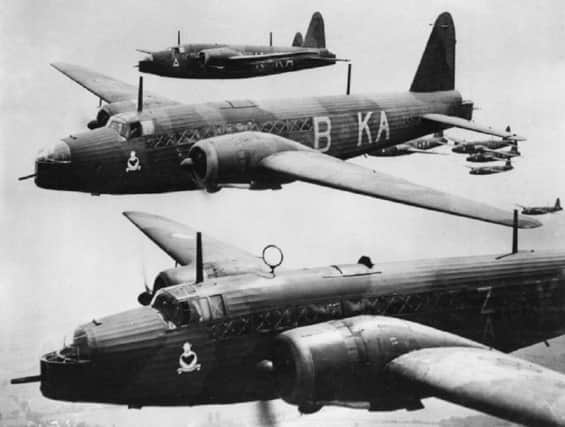Praise for South Shields' hero pilot


Yesterday Dorothy explained how, at 5.15pm on the afternoon of December 27, 1941, Tom and his fellow flyers took off from Methwold to attack the marshalling yards of Dusseldorf.
“As usual, the moment the bomber crossed over the Dutch coast, they were attacked by enemy flak guns,” says Dorothy.
Advertisement
Hide AdAdvertisement
Hide Ad“It was nothing to perturb experienced pilot Thomas Purdy, and he flew on towards their objective of Dusseldorf.”
Stan Barraclough, the wireless operator, reflected at the time: “There were umpteen searchlights, lots of light and heavy flak, and our aircraft were already dropping their bombs.”
Ron Scarlett, the bomb-aimer had just dropped the plane’s load when suddenly the cockpit was brilliantly lit up by searchlights.
“We were in the process of being ‘coned’,” continues Stan Barraclough,”and knew what the result would be if we didn’t shake them off.”
Advertisement
Hide AdAdvertisement
Hide AdTom Purdy pushed the Wellington into a steep dive, and the crew hung on as he took evasive action, and hurtled through the night sky. He levelled out at 1,000ft having lost the searchlights – but that was when disaster struck.
“Streams of incendiary shells ripped through the bottom of the aircraft, setting fire to a large section of the fuselage below the astrodome,” remembers Stan.
“Tom knew that she was finished, and gave the order to abandon the aircraft”
Stan managed to clip on his parachute with difficulty, and followed Ron Scarlett out of the escape hatch.
Advertisement
Hide AdAdvertisement
Hide Ad“Presumably,” supposes Dorothy,”Tom, as pilot, stayed at his controls.
“Hanging on to the end of my parachute I saw the burning aircraft continue on its downward path,” says Stan.
“I did not see anyone else get out, and there was no sign of Ron Scarlett’s parachute in the sky below me”
The Wellington bomber had been riddled with incendiary shells by Hauptman Werner Streib, a German night flyer ace, and it crashed at 20.30pm near Someren, in Holland.
Advertisement
Hide AdAdvertisement
Hide Ad“Stan Barraclough floated down to the ground, and landed on a snow covered field in Holland,” reports Dorothy.
“He sought refuge in a farmhouse, only to find out they were informers, and he was quickly taken prisoner.
Tom’s family had to wait until July 23, 1942, until he was officially declared as killed in action.
Twenty-eight-year-old Tom and his crew, Max, 21, son of E.D.W. and Mary Florence Cronin, of New Zealand; Ron, 27, son of Frederick and Alice Scarlett, of Australia; Bob 26, son of Annie Aldous, of Sandwich, Kent, and Jimmy Poulton are buried in a line together in Woensel Cemetery, Eindhoven.
Advertisement
Hide AdAdvertisement
Hide AdRon Scarlett’s parents included this epitaph on his headstone: “For God, King and country his duty nobly done” which is a fitting and sincere tribute to them all.
On December 24, 1940, Sgt Purdy was awarded the Distinguished Flying Medal.
This is the citation. “Sergeant Purdy has taken part as captain of aircraft in most of the important operations undertaken by the squadron since 4th September 1939, and has at all times shown conspicuous gallantry and determination in pressing home his attacks in the face of severe enemy opposition and in adverse weather conditions. On 18th December 1939, in operations near Heligoland he was responsible for the destruction of three enemy aircraft. His success as a captain of aircraft is no less marked than his skill and determination as a pilot and he has imbued his crew with a team spirit to a marked extent. By his courage, persistent determination, skill and power of leadership, this N.C.O. has at all times set an example deserving of the highest praise.”